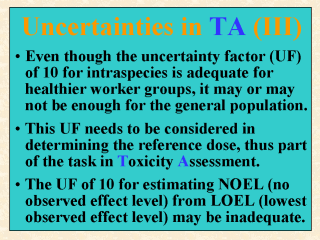| front |1 |2 |3 |4 |5 |6 |7 |8 |9 |10 |11 |12 |13 |14 |15 |16 |17 |18 |19 |20 |21 |22 |23 |24 |25 |26 |27 |review |
 |
Another
uncertainty factor (UF) commonly considered in toxicity assessment is the 10-fold factor
for intraspecies sensitivity, because it has a direct effect on the determination of
reference dose or acceptable daily intake (see Slide 11). Where the human exposure
was calculated for populations other than workers, shouldn't this UF be greater than 10 to
account for the lack of the healthy worker effect (USEPA, 1999b)? Or should this UF be less than 10 when worker exposure is considered? By healthy worker effect, it means the worker group is likely to be healthier and hence less susceptible than the young and elderly in the general population. If the intraspecies sensitivity is truly within an order of magnitude, then why would it be necessary for USEPA (2000d) to strive for a 99.9th percentile exposure for acute dietary intake assessment? After all, such an estimate is less stable than a 95th percentile (see, e.g., Finley and Paustenbach, 1994). And by default, the UF of 10 for intraspecies sensitivity should be considered adequate to protect consumers of all ages and genders. It is also customary for regulatory agencies to divide the LOEL (lowest observed effect level) by an UF of 10 to estimate the NOEL (no observed effect level), when the latter cannot be identified from the toxicity study used. The adequacy of this UF of 10 is likewise questionable. This default assumption asserts that a dose at one-tenth of the experimental LOEL would be low enough to reach the actual NOEL in question. Yet some experimental LOEL could be several times greater than the actual LOEL. And the latter in turn could easily be an order of magnitude or so greater than the actual NOEL. |